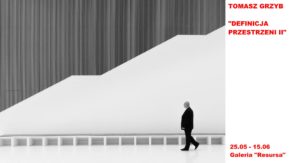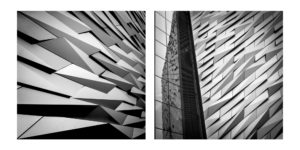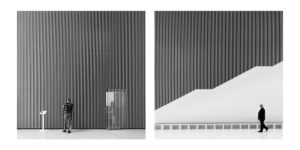 Together with the Resursa Gallery, I invite you to the opening of the exhibition entitled ‘Definition of Space II’ on Friday, 25 May at 7 p.m. This is the second part of the exhibition, which was previously on display at the MCSW “Elektrownia” as part of the ‘FotoGENY’ exhibition.
Together with the Resursa Gallery, I invite you to the opening of the exhibition entitled ‘Definition of Space II’ on Friday, 25 May at 7 p.m. This is the second part of the exhibition, which was previously on display at the MCSW “Elektrownia” as part of the ‘FotoGENY’ exhibition.
Elżbieta Raczkowska (exhibition curator):
In order to properly understand the concept of space, the author quotes prominent scholars in the exhibition information. For Democritus, space is emptiness; according to Bernardino Telesio, it is a system of relationships between things; and in Immanuel Kant’s interpretation, it is an image that cannot be removed from thought.
At this point, one may ask whether Tomasz Grzyb was guided by these definitions when perceiving the space around him, or whether he took their meaning into account and used this wisdom in his artistic work. Or perhaps he applied them selectively, succumbing mainly to his own feelings and perceptions? The theories of Telesio and Kant (despite the time difference between their publication) seem to be closest to the author, which, when combined, assume both a physical and emotional relationship between humans and the concept of space.
The subject of Tomasz Grzyb’s work is contemporary architecture framed and cut out of the general context of the whole. In this way, new, original artistic creations have been created, living their own lives.
The space he presents is of particular interest to the author due to the fragmentary complexity of the combination of harmonious lines and structures; it automatically creates new forms, which are components of individual images, as if they were set in a reality different from ours.
All of the author’s intentions were deliberately incorporated into the square form, perceived as perfectly neutral, even perfect, without imposing a multitude of expositions. The presented content goes beyond the two-dimensionality of the proposed surface and reveals the author’s tendency to use light and shadow to create interesting models and convey specific emotional content to the viewer. Some follow the dramaturgy of representations using strong textures and expressive chiaroscuro, while others, muted, light in their genre and devoid of clear tonal differences, seem to leave them in stark contrast. The ‘Definition of Space’ masterfully presented by the photographer, deliberately devoid of colour, almost ascetic and intentionally enclosed in diptych forms, has a particularly strong effect on the viewer. It becomes (following Kant’s idea) an image that is impossible to forget.

